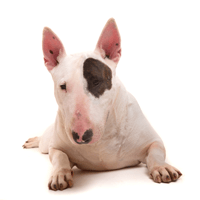
Avg Size of male: Height: 21 – 22 inches, Weight: 60 – 70 pounds
Minor concerns: Heart problems, patellar luxation
Occasionally seen: Lens luxation
Suggested tests: Hearing (whites), UP:UC ratio for kidney function, cardiac, eye
Avg Size of Female: Height: 21 – 22 inches, Weight: 50 – 60 pounds
Life span: 11 – 14 years
Major concerns: Deafness (whites), kidney problems
Brief History on Bull Terrier Origin
It was in 1860 that breeders decided to create an exclusively all white dog, and James Hinks is credited with crossing the “bull and terrier” with a white English terrier and a Dalmatian to produce the very fashionable and sought after, White Bull Terrier. This breed has also been used over the years as a patrol or guard dog, a ratter, and even a herder. Over time the breed maintained its unique head shape, while the body became more & more streamlined. In the early 1900s, the White Bull Terrier was crossed with the Staffordshire Bull Terrier which resulted in the creation of the colored Bull Terrier. The Colored Bull Terrier was recognized as an official separate variety of the breed by the AKC in 1936. To date the white variety is much more popular and reputable, and the dog’s comical expression and one-of-a-kind characteristics has been seen in several movies and many advertising campaigns.
Bull Terrier Breed Appearance
Slightly longer than it is tall, the Bull Terrier is a muscular dog of strong yet short stature. The front legs are medium in length and straight. The hind legs feature very muscular, firm thighs. The feet are compact and somewhat cat-like. The head is elongated with what is described as a “crooked” and downward pointing muzzle. The ears usually stand tall and pointed upwards. The squinting, dark and triangular eyes of this breed offer an intelligent expression. The nose is usually black. The neck is long and muscular, and it tapers cleanly from the head into the shoulders. The breed’s tail is set low, straight and is normally carried horizontally. It is thick at the base and tapers down to a thinner point. The gait of this breed is described as speedy and powerful. The bull terrier comes in two coat varieties, only white and colored.
Bull Terrier Breed Temperament
Many have been known to describe the Bull Terrier as a comical dog with a stubborn streak. It is generally a good-natured dog, especially when trained at a young age. It is better suited for a family with older children that have a good understanding of how animals need to be treated, since this breed does not like teasing. The bull terrier should generally not be in a home with other small animals. Although it is not impossible, as long as you socialize this breed at a young age with non-canine animals. It can be aggressive with other unfamiliar dogs, although multiple Bull Terriers may get along perfectly fine in the same household. This breed does not do well if left alone for long periods of time, it may cause some destruction in the home and or grow anxious habits. Firm training is important, but the bull terrier can sometimes be difficult to manage. This breed requires an owner with patience and understanding. This dog is known to be very protective of its family and can be a wonderful companion if provided with the right socialization and training from the very beginning.
Bull Terrier Breed Maintenance
Coat care for the Bull Terrier does not require much maintenance. The occasional combing with a firm bristle brush will definitely suffice. The loose hair is easily removed with a daily rubdown with some type of shedding glove, which will also keep the coat looking healthy, shiny and cared for. Bathe only when necessary to keep the dog’s natural skin oils plentiful. This energetic breed loves to be entertained and have fun, and both physical and mental exercise is required daily. It should be allowed to run in secured areas only, and it should be kept on a leash at all times when out for a walk. Without sufficient exercise, the Bull Terrier is known to become lazy and overweight. This dog will do okay in an apartment building as long as it is provided with enough outdoor activity and exercise. You should also note that it is important to socialize puppies from the very beginning, to prevent them from getting into dominating tendencies when they are grown.
 Toledo, United States.
Toledo, United States.